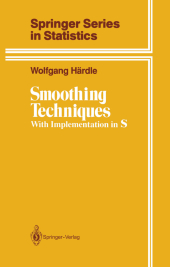 Neuerscheinungen 2011Stand: 2020-01-07 |
Schnellsuche
ISBN/Stichwort/Autor
|
Herderstraße 10
10625 Berlin
Tel.: 030 315 714 16
Fax 030 315 714 14
info@buchspektrum.de |

Wolfgang Härdle
Smoothing Techniques
With Implementation in S
2011. xii, 262 S. XI, 261 pp. 87 figs. 235 mm
Verlag/Jahr: SPRINGER, BERLIN 2011
ISBN: 1-461-28768-5 (1461287685)
Neue ISBN: 978-1-461-28768-1 (9781461287681)
Preis und Lieferzeit: Bitte klicken
The author has attempted to present a book that provides a non-technical introduction into the area of non-parametric density and regression function estimation. The application of these methods is discussed in terms of the S computing environment. Smoothing in high dimensions faces the problem of data sparseness. A principal feature of smoothing, the averaging of data points in a prescribed neighborhood, is not really practicable in dimensions greater than three if we have just one hundred data points. Additive models provide a way out of this dilemma; but, for their interactiveness and recursiveness, they require highly effective algorithms. For this purpose, the method of WARPing (Weighted Averaging using Rounded Points) is described in great detail.
I. Density Smoothing.- 1. The Histogram.- 1.0 Introduction.- 1.1 Definitions of the Histogram.- The Histogram as a Frequency Counting Curve.- The Histogram as a Maximum Likelihood Estimate.- Varying the Binwidth.- 1.2 Statistics of the Histogram.- 1.3 The Histogram in S.- 1.4 Smoothing the Histogram by WARPing.- WARPing Algorithm.- WARPing in S.- Exercises.- 2. Kernel Density Estimation.- 2.0 Introduction.- 2.1 Definition of the Kernel Estimate.- Varying the Kernel.- Varying the Bandwidth.- 2.2 Kernel Density Estimation in S.- Direct Algorithm.- Implementation in S.- 2.3 Statistics of the Kernel Density.- Speed of Convergence.- Confidence Intervals and Confidence Bands.- 2.4 Approximating Kernel Estimates by WARPing.- 2.5 Comparison of Computational Costs.- 2.6 Comparison of Smoothers Between Laboratories.- Keeping the Kernel Bias the Same.- Keeping the Support of the Kernel the Same.- Canonical Kernels.- 2.7 Optimizing the Kernel Density.- 2.8 Kernels of Higher Order.- 2.9 Multivariate Kernel Density Estimation.- Same Bandwidth in Each Component.- Nonequal Bandwidths in Each Component.- A Matrix of Bandwidths.- Exercises.- 3. Further Density Estimators.- 3.0 Introduction.- 3.1 Orthogonal Series Estimators.- 3.2 Maximum Penalized Likelihood Estimators.- Exercises.- 4. Bandwidth Selection in Practice.- 4.0 Introduction.- 4.1 Kernel Estimation Using Reference Distributions.- 4.2 Plug-In Methods.- 4.3 Cross-Validation.- 4.3.1 Maximum Likelihood Cross-Validation.- Direct Algorithm.- 4.3.2 Least-Squares Cross-Validation.- Direct Algorithm.- 4.3.3 Biased Cross-Validation.- Algorithm.- 4.4 Cross-Validation for WARPing Density Estimation.- 4.4.1 Maximum Likelihood Cross-Validation.- 4.4.2 Least-Squares Cross-Validation.- Algorithm.- Implementation in S.- 4.4.3 Biased Cross-Validation.- Algorithm.- Implementation in S.- Exercises.- II. Regression Smoothing.- 5. Nonparametric Regression.- 5.0 Introduction.- 5.1 Kernel Regression Smoothing.- 5.1.1 The Nadaraya-Watson Estimator.- Direct Algorithm.- Implementation in S.- 5.1.2 Statistics of the Nadaraya-Watson Estimator.- 5.1.3 Confidence Intervals.- 5.1.4 Fixed Design Model.- 5.1.5 The WARPing Approximation.- Basic Algorithm.- Implementation in S.- 5.2 k-Nearest Neighbor (k-NN).- 5.2.1 Definition of the k-NN Estimate.- 5.2.2 Statistics of the k-NN Estimate.- 5.3 Spline Smoothing.- Exercises.- 6. Bandwidth Selection.- 6.0 Introduction.- 6.1 Estimates of the Averaged Squared Error.- 6.1.0 Introduction.- 6.1.1 Penalizing Functions.- 6.1.2 Cross-Validation.- Direct Algorithm.- 6.2 Bandwidth Selection with WARPing.- Penalizing Functions.- Cross-Validation.- Basic Algorithm.- Implementation in S.- Applications.- Exercises.- 7. Simultaneous Error Bars.- 7.1 Golden Section Bootstrap.- Algorithm for Golden Section Bootstrapping.- Implementation in S.- 7.2 Construction of Confidence Intervals.- Exercises.- Tables.- Solutions.- List of Used S Commands.- Symbols and Notation.- References.
The book is addressed to both the theoretical and applied statistician. It can be used as an undergraduate text.


